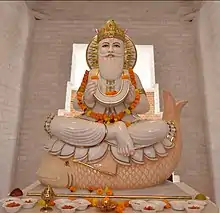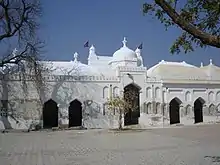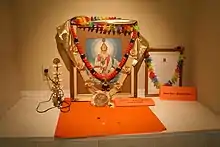| Bhagwan Jhulelal | |
|---|---|
 Jhulelal, incarnation of Varuna, sitting on a lotus flower in the middle of a river and surrounded by a couple of silver fish (palla fish) | |
| Affiliation | Varuna Deva |
| Abode | Sea & River Indus |
| Mantra | Om Vam Varunaya Namah |
| Weapon | Sword |
| Mount | Hilsa Fish & Horse |
| Personal information | |
| Siblings | Soma Rai & Bheda Rai |
A folkloric deity among the sect of Sindhis, Jhulelal (Sindhi: جھوليلال; झूलेलाल) is the most revered deity of Sindhi Hindus in the modern-day republics of Pakistan and India.[1][2][lower-alpha 1]
Legends converge upon that Jhulelal was born during the rule of one Islamic despot "Mirkshah", who had issued an ultimatum to local Sindhis for converting to Islam.[1][4] The reincarnation of a Sindhi deity, Jhulelal exhibited supernatural powers since childhood; he preached about how the Muslims believed in the same God, and emphasized that the Koran forbade forced conversion.[1][2] Ultimately, Jhulelal convinced the King to spare the Hindus and even gained devotees among the Muslims.[1][2]
Devotion towards Jhulelal was very uniform in pre-partition Sindh and he was one of the many deities belonging to the Sindhi cultural pantheon.[1][2] However, in 1950 Indian Sindhis, led by Ram Panjwani in Bombay, decided to transform Jhulelal into the icon of unity for all Sindhis and unify the sindhi community.[1][2] Devotional songs were penned, pamphlets printed, statues installed, festivals celebrated, and cultural events organized in thousands for the cause of Jhulelal.[1] Over the course of decades, Jhulelal has successfully become the representative Unifying God of Sindhis.[1]
Iconography of Jhulelal varies widely.[1][5] Sindhi Hindus worship Jhulelal at the Shrine at Odero Lal in Pakistan's Sindh province, which is jointly used by Sindhi Hindus, and Sindhi Muslims who revere the shrine as the tomb of Sheikh Tahir. A second shrine named Jhulelal Tirthdham exists in India at Narayan Sarovar, Kutch, Gujarat.[6]
Folklore
Rough summary
After a long period of harmonious existence between the Hindus and Muslims, one Mirkshah of Thatta ascended the throne.[2] Instigated by his advisors, he ordered that all local Hindus convert to Islam or be put to death.[2] The Hindus prayed to Indus, who promised that Varuna will take the form of a child and avert the impending catastrophe.[2]
In 1007, the day of Cheti Chand in Chaitra, one Uderolal was born to a local Hindu family of Arora caste.[7][8][2] As he began to be worshiped, Mirkshah sent his ministers to investigate who witnessed various strange events.[2] The child metamorphosed into a young warrior, then into an old man, before back to child; at other times, he swam upstream on a fish.[2][lower-alpha 2] Mirkshah grew afraid but his advisors coerced him to hold stead.[2]
Soon, he went to meet Uderolal and was impressed by his understanding of Islam — Uderolal preached about how the Hindus and Muslims believed in the same God, and the Koran forbade conversion.[2][1] However, his advisors suggested that his teachings be disregarded and Uderolal imprisoned.[2] When the guards proceeded to arrest him, an inferno and a flood engulfed his palaces.[2][1] Mirkshah relented, abolished his decree, and asked for forgiveness from Uderolal.[2]
As the palace was saved and harmony restored, Jhulelal gained devotees even among the Muslims (including Mirkshah).[2] Jhulelal requested that a flame be burnt for eternity, in the memory of his deeds, before leaving his earthly avatar.[1]
Variant readings
The myth of Jhulelal is not seen in regional histories written prior to the 20th century. While all Jhulelal legends broadly revolve around two themes — the valorization of Sindhi communal harmony and the intrinsic superiority of tolerant and devout Hindus over Muslims who weren't even able to interpret their own religious texts — the specifics vary widely and have even been a site of internal contestation among Sindhi Hindus.[2] Moreover Sindhi Muslims have forged their own legends concerning Jhulelal.[2]
Hindus
The birth-name varies from Uderolal to Amarlal to Daryasahib; the event of his first appearance is either noted to be from a human birth or from the Indus, riding on a fish.[2] He is variously noted as an avatara of Vishnu or a manifestation of Varuna; one conflates the two to deem him as the Varuna avatara of Vishnu.[2] How he came to be known as Jhulelal attracts another set of fascinating claims.[2] The transpirings that arose out of his encounter with Mirkshah varies — some claim that the King had submitted long ago in the face of his supernatural powers while others claim that Jhule Lal led a secretly gathered force to victory in an old-school war.[2]
The presentation of the narrative differs too.[2] Many renderings choose to emphasize on the cruelty of Muslim rulers against Brahmins (and Hindus, by extension) — a column in Indian Express had projected contemporary Hindu Nationalism onto the narrative with Jhule Lal "fill[ing] the shrinking Hindus with courage" and "put[ting] holy terror into the persecuting Muslims" while some Sindhis have transplanted Jhulelal into the reign of Aurangzeb, a ruler notoriously renowned in public memory for being the worst persecutor of Hindus.[2] Some choose to emphasize on the Hinduness of Jhulelal drawing tenuous connections with Vedic corpus.[2]
Festivals
Cheti Chand
The Cheti Chand festival in the month of Chaitra, marks the arrival of spring and harvest, as well as the incarnation day of Uderolal in the Vikram Samvat calendar year 1007.[1][2] Uderolal morphed into a warrior and old man who preached and reprimanded Mirkhshah that Muslims and Hindus deserve the same religious freedoms. He, as Jhulelal,[2] became the saviour of the Sindhi Hindus, who according to this legend, celebrate the new year as Uderolal's birthday.[2][1]
Chaliya saheb
Chalio or Chaliho, also called Chaliho Sahib, is a forty-day-long festival celebrated by Sindhi Hindus[9][10][11] to express their gratitude to Jhulelal for saving them from their impending conversion to Islam. The festival is observed every year in the months of July to August; dates vary according to Hindu calendar.[9][10] It is a thanksgiving celebration in honor of Varuna Deva for listening to their prayers.[9][10]
Shrines
Odero Lal Shrine


The Jhulelal Shrine at Odero Lal is situated in Matiari District, almost 40 kilometers away from the Sanghar District of Sindh; The Hindus and the Muslims can pray here at the same place simultaneously.[12][13] Nawabshah, Hyderabad, Matiari, Sanghar and Mirpur Khas are the nearby major cities to reach at the Shrine near Tando Adam.[14]
It forms the seat of the Daryapanthis, originally a subsect of the followers of Gorakhnath, who belong to the Nath tradition.[15][16]
Jhulelal Tirthdham
Sindhi Hindus in India built a religious shrine and cultural complex in Kutch (GUJRAT) State of India, near the border of Sindh Province.[17][6] The 100-acre complex includes a 100-foot statue of Lord Jhulelal, a museum, meditation centre, an auditorium, and a cultural and arts-and-crafts centre with 100 accommodations.[17][6] Aiming to be the "a centre for global Sindhi identity",[6] the project costs an estimated ₹100 crore and was built on the donations from wealthy Indian Sindhis.[17][6] Harish Fabiani, one of the key promoters of the project, stated regarding the cultural complex, "The younger generation is aware they are Sindhis, but they do not know their language. We must learn our language and culture. We should have a place we can call our own."[17]

Iconography
- In the most common form, Jhulelal is represented as a bearded man sitting cross-legged on a lotus flower that rests on a palla fish.[18] The fish is seen floating on the Sindhu river. He holds a sacred text and sometimes even a rosary. He wears a golden crown with a peacock feather and wears regal clothes. Generally, temple idols represent him in this form.[1][19]
- In another form, he is shown standing on a palla fish or the lotus flower, holding a staff with both hands to indicate leadership.[1]
Notes
See also
References
- 1 2 3 4 5 6 7 8 9 10 11 12 13 14 15 16 Mark-Anthony Falzon (2004). Cosmopolitan Connections: The Sindhi Diaspora, 1860–2000. BRILL. pp. 58–60. ISBN 90-04-14008-5.
- 1 2 3 4 5 6 7 8 9 10 11 12 13 14 15 16 17 18 19 20 21 22 23 24 25 26 27 28 29 Ramey, Steven W. (2008), Ramey, Steven W. (ed.), "Presenting Sacred Figures", Hindu, Sufi, or Sikh: Contested Practices and Identifications of Sindhi Hindus in India and Beyond, New York: Palgrave Macmillan US, pp. 105–124, doi:10.1057/9780230616226_5, ISBN 978-0-230-61622-6, retrieved 2021-08-24
- 1 2 Lari, Suhail Zaheer (1994). A history of Sindh. Oxford. ISBN 0195775015. Retrieved 19 December 2017.
- ↑ Bhavnani, Nandita (2014). The Making of Exile: Sindhi Sindhis and the Partition of India. Westland. ISBN 9789384030339.
- ↑ "Jhulay Lal's full circle". 20 December 2015.
- 1 2 3 4 5 "Coming up in Gujarat, Sindhis' own sacred shrine - Times of India". The Times of India. Retrieved 12 May 2019.
- ↑ Gopal, Dr Krishna (2003). Fairs and Festivals of India. Gyan Publishing House. ISBN 978-81-212-0810-9.
- ↑ Registrar, India Office of the (1962). Census of India, 1961. Manager of Publications. p. 28.
- 1 2 3 Chaliho festival Archived September 16, 2011, at the Wayback Machine
- 1 2 3 Sindhis celebrate Chalio festival
- ↑ Sindhi Festivals > Chaliho Archived April 25, 2012, at the Wayback Machine
- ↑ Zahida Rehman Jatt (June 3, 2015). "Jhulay Lal's cradle of tolerance". Dawn. Dawn. Retrieved 22 December 2015.
- ↑ Claude Markovits (22 June 2000). The Global World of Indian Merchants, 1750–1947: Traders of Sind from Bukhara to Panama. Cambridge University Press, 2000. p. 48. ISBN 9781139431279. Retrieved 22 December 2015.
- ↑ "List of Cities near Udero Lāl in Sindh, Pakistan". GoMapper. Retrieved 22 December 2015.
- ↑ "Story of Jhulelal". Archived from the original on 2011-05-31. Retrieved 2011-05-01.
- ↑ Jatt, Zahida Rehman (2017-03-07). "How this lesser known festival is celebrated annually by Hindus in Sindh". DAWN.COM. Retrieved 2018-09-16.
- 1 2 3 4 Shradha Shahani (5 June 2019). "Sindhis are building a Jhulelal Tirthdham—their own holy city". Retrieved 5 June 2019.
- ↑ Nadeem F. Paracha (December 20, 2015). "Jhulay Lal's full circle". Dawn. Dawn. Retrieved 22 December 2015.
- ↑ Boivin, Michel (15 Oct 2008). Sindh through History and Representations: French Contributions to Sindhi Studies. Oxford University Press. p. 76. ISBN 9780195475036.
